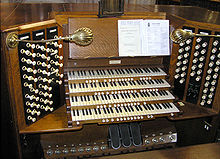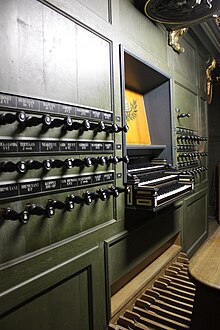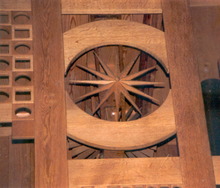Organ
An organ is an wind/keyboard instrument that developed from the Roman hydraulus (invented c.40 BCE), a loud stadium instrument. It made its way into churches in the middle ages and into concert halls and civic centers (at least in large numbers) in the 19th century.
Current Form
[edit | edit source]Organs today exist in two main varieties, electronic and pipe. The controls for both kinds are very similar.
Consoles
[edit | edit source]Console designs vary widely based upon the type of organ and its size; however, certain rules hold true for most organs. There are one or (usually) more keyboards (called manuals) placed one above the other. (On a two manual organ, the upper is known as the Swell and the lower as the Great). The American Guild of Organists (AGO) has set standards for console construction, one of which are the dimensions for manuals. They call for 61 notes on each manual (C-C). Most organs also have a collection of controls near the organist's feet. One or more expression pedals (also called a "swell shoe") control the volume of different divisions of the organ. Many organs also have an additional pedal to the right of the expression shoes called the "crescendo shoe" which adds stops to the extant ensemble incrementally to build up the sound. This pedal is almost always set slightly farther forward than the others to distinguish it when the organist is looking at the music, rather than his/her feet. Pedals are laid out as keyboard (replicating the bottom of the manuals) and are used to provide bass notes. The AGO standard calls for 32 pedals (C-g).
American Consoles

Organ consoles in the United States and Canada tend to display similar design characteristics. For one thing, AGO standards are nearly always adhered to, meaning that manuals have 61 keys, pedalboards are concave and radiating with 32 pedals. These consoles usually have some sort of music rack that is attached to them. These are made of wood, glass, plexiglass, or some combination thereof and can be fixed or fold into the console to cover the manuals or fold back and latch onto the top of the console. Another common feature of the American console is the presence of some sort of rolling cover for the manuals and stop controls. Aside from that, though, there are two primary styles within this category, which are based upon the types of stop controls being used.
Tab Consoles

Organs with tabs that serve as stop controls are common in North America, especially with electronic organs. These tabs may physically move, or they may simply light up when activated. Rocker tabs tend to be placed in one or two rows on the nameboard of the console. Some more modern consoles, however, opt to place them on angled jambs on either side of the organist. These jambs are usually positioned diagonally and follow the contour of the keycheeks, unlike those which bear drawknobs. Tongue tabs are increasingly unpopular because their cost is similar to that of drawknobs, which have more aesthetic appeal. However, these tabs are also usually placed above the uppermost manual (the nameboard).
Drawknob Consoles
These consoles use drawknobs to control the various stops of the organ. These drawknobs are generally mounted on diagonally angled jambs on either side of the organist. The jambs tend not to extend more than 8-10" above the uppermost manual. The drawknobs traditionally move in and out (in being inactive and out being active) based upon the organist's desired sound. Traditional American drawknobs are two-toned: black stems with white faces. The materials used to make these knobs varies from plastic to ebony and from rosewood to ivory. Also, various colors and combinations are used, depending on the color of the console. The travel distance of these drawknobs is known as the "throw" and is usually between 1/2" and 1 1/4" for American organs. Lighted drawknobs are being utilized, but almost exclusively with low-end electronic organs. These drawknobs are depressed or pulled to activate or deactivate various ranks, but they generally do not remain in the position they are pushed or pulled into. Some smaller organs can use drawknobs mounted on the nameboard, but the severely limited size makes this impractical in most cases. Also, in American organs, intermanual couplers are usually not assigned to drawknobs, even with a drawknob console. They will usually be placed on rocking tabs above the uppermost manual. Intramanual couplers, on the other hand, are usually included with the stop complements of the divisions they affect.


English Consoles

English consoles tend to be most similar to American consoles in that they often conform to AGO standards and they utilize similarly shaped drawknobs. There are, however, a few differences. The first is the music rack. English consoles usually employ a solid wood music rack that is mounted within the console and is in a fixed position. Small brass clamps are often found near the bottom to secure the music. This arrangement adds to the height of the console, making is difficult to see over the top, especially with large consoles. Also, it is not practical to employ a roll top, so most consoles are open, though a few have glass doors than enclose the manuals and jambs. Furthermore, there tends not to be enough room on the nameboard for rocker tabs, so all of the couplers are usually controlled by drawknobs. The drawknobs themselves are traditionally all white, though this is certainly subject to variation.
French Consoles
French consoles are unique in their terraced design. They use drawknobs in stacked rows on either side of the organist. These terraces can be straight, angled, or curved (a style used by prolific French organ builder Aristide Cavaillé-Coll). Couplers are usually of the hitch-down variety, meaning that a foot pedal can be depressed to activate them and moved back into its normal position to deactivate them. Pedalboards on French consoles tend to be straight. The drawknobs of these consoles tend to be large and made of wood. The throw can be anywhere from 1" to 6" or more, with the longer travel being associated with mechanical, or "tracker" action organs.
German, Dutch, and Spanish Keydesks


A keydesk is simply a console that is a part of the organ case This style can be seen in nearly every country where organs are prominent, but nowhere is it more common than in south-central Europe. Keydesks were the original organ consoles, which makes sense because the early mechanical action instruments would have had to keep things compact. Having the console as part of the organ case was a very effective way of doing that. What makes these types of keydesks unique, though, is their size and configuration. They were designed to accommodate a registrant (or two), a person who manipulated the stops for the organist. The stops were to large and heavy for the organist to manipulate quickly, so extra help was necessary for these instruments. The larger keydesks of this style have stops extending several feet away from the organist.
Unusual Console Styles
Some organ builders just have a knack for making things that defy convention. Organ consoles have been made in many varieties for various purposes. Some of the more distinct builders for strange consoles include Walter Holtkamp, who specialized in consoles without sides. Theater organs also employ artful craftsmanship and outrageous design to captivate audiences. These consoles are often found in outrageous colors with all sorts of designs and creatures adorning them.
Stops
[edit | edit source]Both pipe and electronic organs utilize a series of controls, known as stops, to control the generate a variety of different individual sounds. These stops are divided into four primary categories:
Principals


Principal stops are the backbone of the organ. They do not imitate any orchestral instrument. In essence, they are what makes an organ sound like an organ. They come in a variety of tonal "colors" and are most commonly used in hymn singing. Principal stops are available in a variety of pitches; the most common are 32', 16', 8', 4', 2 2/3', 2', 1 1/7', & 1 1/3'. As with all organ stops, there are several names for principals in several languages. The most common include Principal, Diapason, Open Diapason, Octave (for higher pitched stops), Prestant, Montre, Fifteenth (2' pitch), Super Octave, etc. Also grouped with the principal stops are "Mixture" stops. These high-pitched compound stops serve to clarify melodic lines or to make it easier to activate multiple ranks of pipes using a single drawknob or tab. Mixtures are unique in that they utilize several ranks and their harmonics don't progress like other stops. Often the pitch of a mixture stop will remain relatively constant between octaves. This phenomenon is best seen by playing scales using just a mixture stop. Mixtures can be denoted at the console by a roman numeral indicating the number of ranks the mixture utilizes. Common mixtures include Mixture, Plein Jeu, Fourniture, Scharf(f), Sharp, Cornet (a compounding of principal stops), Acuta, etc. When the full principal chorus is used, consisting of (16',) 8', 4', (2 2/3'), 2', (1 3/5',) (Mixture(s)), it is often referred to as "Plenum" registration (or "Organo Pleno"). Principal pipes are usually made of metal, but can also me made of wood. Metal principal pipes often made up the façade of an organ.
Flutes
Flute stops comprise the second and most widely varied type of organ sounds. They tend to be lighter and more breathy than principals, though not always. They tend have more orchestral flute-like qualities. Some flute stops are imitative of orchestral flutes (like the aptly named “Orchestral Flute”) while others are unique to the organ. Flutes are used in lighter music and choral accompaniment, but rarely to accompany congregational singing. Flute pipes can be made of either wood or metal.
Strings
String stops are the lightest of the organ stops, some being almost inaudible. They are almost never used in congregational singing and tend to be used in “placeholder” service music, as well as many organ works of the romantic period. String stops are usually found only at 8’ pitch, though a few 16’ and 4’ string stops exist. Strings have a warm sound that is evocative of orchestral strings, though not quite imitative. The full beauty of string stops is realized when they are used in conjunction with their “celeste” counterparts. Celeste stops are identical to the regular string stops, except they are tuned 3-8 Hz faster, making them slightly sharp. When used together, a string and its celeste create a deep undulating effect. String ranks are almost always made of metal.
Reeds

Reed stops are the final variety of organ stops. They are generally the loudest and are divided into two subcategories: chorus reeds and solo reeds. Chorus reeds are meant to build on and clarify the principal chorus. They highlight the melodic line of a piece and add volume and grandeur. The most common chorus reed is the 8’ Trumpet, but there are several softer varieties (like the 8’ Cornopean). Solo reeds are meant to carry the melodic line by themselves. They are usually played with one hand while the accompaniment is played by the other on a different manual. One of the loudest and grandest of these stops is the Trompette en Chamade, also known as a State Trumpet, Heroic Trumpet, Herald Trumpet, and Festival Trumpet (among other names). Chamade stops are usually mounted horizontally, jutting out from the organ case (if the organ has any visible casework). Another common solo reed is the Oboe, generally one of the most imitative organ stops. The majority of reed pipes are made of metal and are different in form than the other three types of pipes (all of which are “flues”).
Percussion

Percussive stops are common on many larger organs, especially theatre organs. They may be drums, cymbals, or other sounds. The two most common are the Zimbelstern (German for "bell star") and chimes.
Through proper manipulation of these stops, the operator can create many interesting and unique sounds.
Reading music for the Organ
[edit | edit source]The basic elements of written organ music are same as those of any other instrument; as this information can be found on other pages of the School of Music and Dance it will not be included here.
The organ is a polyphonic instument written on two or three staves. When written on three staves, one is provided for each manual, while on the third is music for the foot pedals. This style, however, is not universal, for three staves occupy a great deal of space and thus are expensive to print and difficult to read. Therefore, the staves for the lower manual and the foot pedals are often combined.
